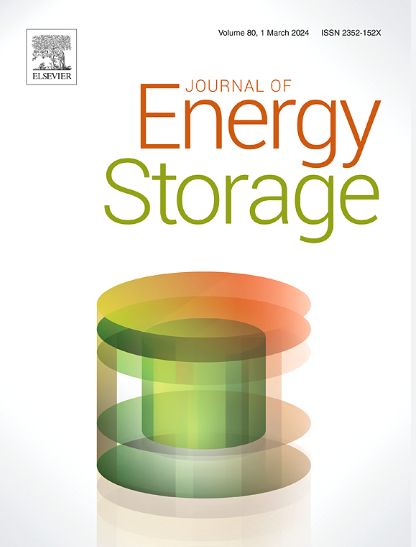Progressive degradation and regeneration pathways in O3-NaNi1/3Fe1/3Mn1/3O2 under long-term low-humidity air exposure
IF 8.9
2区 工程技术
Q1 ENERGY & FUELS
引用次数: 0
Abstract
This study systematically reveals the failure mechanisms of O3-type layered oxide NaNi1/3Fe1/3Mn1/3O2 (NFM) during long-term air exposure and their impact on electrochemical performance. Through multi-scale characterization, including X-ray diffraction (XRD), high-resolution transmission electron microscopy (HRTEM), X-ray photoelectron spectroscopy (XPS), and Fourier-transform infrared spectroscopy (FTIR), combined with electrochemical analysis, we demonstrate that Na+ migration and CO2/H2O synergistic reactions are the primary drivers of degradation. These processes induce the progressive growth of surface Na2CO3/HCO3− impurities, accompanied by lattice distortion (a-axis contraction by 0.94 % and c-axis expansion by 0.74 %) and partial Mn3+ oxidation (Mn4+ proportion increased to 52.6 %). These combined effects result in severe electrochemical deterioration: samples exposed for 15 days exhibit a 50.3 % initial capacity decay (from 129.9 to 64.6 mAh/g), and a tenfold decrease in Na+ diffusion coefficient. Notably, a 7-day exposure to a CO2 atmosphere with trace moisture triggers surface carbonation reactions, emphasizing exposure duration as a critical variable under trace moisture conditions. Furthermore, this study proposes a ‘de-intercalation-framework reversibility’ mechanism: although water soaking induces 80 % Na+ extraction and partial TM-O framework distortion, low-temperature re-sodiation effectively repairs the lattice and restores the O3 structure. These findings provide theoretical insights and technical pathways for the failure prevention and regeneration of highly air-sensitive sodium-ion cathode materials.
长期低湿空气暴露下O3-NaNi1/3Fe1/3Mn1/3O2的递进降解和再生途径
本研究系统揭示了o3型层状氧化物NaNi1/3Fe1/3Mn1/3O2 (NFM)在长期暴露于空气中的失效机理及其对电化学性能的影响。通过x射线衍射(XRD)、高分辨率透射电子显微镜(HRTEM)、x射线光电子能谱(XPS)和傅里叶变换红外光谱(FTIR)等多尺度表征,结合电化学分析,我们证明了Na+迁移和CO2/H2O协同反应是降解的主要驱动因素。这些过程诱导了表面Na2CO3/HCO3−杂质的逐渐增长,并伴随着晶格畸变(a轴收缩0.94%,c轴膨胀0.74%)和部分Mn3+氧化(Mn4+比例增加到52.6%)。这些综合效应导致了严重的电化学退化:暴露15天的样品显示50.3%的初始容量衰减(从129.9 mAh/g降至64.6 mAh/g), Na+扩散系数降低了10倍。值得注意的是,暴露于含有微量水分的二氧化碳大气中7天会触发表面碳化反应,强调暴露时间是微量水分条件下的关键变量。此外,本研究提出了一种“脱嵌层-框架可逆”机制:尽管水浸泡导致80%的Na+萃取和部分TM-O框架畸变,但低温再调解有效地修复了晶格并恢复了O3结构。这些发现为高气敏钠离子阴极材料的失效预防和再生提供了理论见解和技术途径。
本文章由计算机程序翻译,如有差异,请以英文原文为准。
求助全文
约1分钟内获得全文
求助全文
来源期刊

Journal of energy storage
Energy-Renewable Energy, Sustainability and the Environment
CiteScore
11.80
自引率
24.50%
发文量
2262
审稿时长
69 days
期刊介绍:
Journal of energy storage focusses on all aspects of energy storage, in particular systems integration, electric grid integration, modelling and analysis, novel energy storage technologies, sizing and management strategies, business models for operation of storage systems and energy storage developments worldwide.
 求助内容:
求助内容: 应助结果提醒方式:
应助结果提醒方式:


